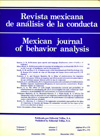The effect of cycle length, interstimulus interval and probability of reinforcement in autoshaping
Main Article Content
Abstract
The groups of pigeons, esach with a different and constant reinforcement cycle, were exposed to the following manipulations: first, holding reinforcement probability constant at 1.00, the interval between reinforcement and a 4-sec neutral stimulus was gradually increased. Second, using a constant 4-sec interstimulus interval, probabiity of reinforcentent was decreased. Third, at a constant 8-sec interstimulus interval, probability of reinforcement was again decreased. It was found that the rate during the stimulus was a monotonically decreasing function of lengthening the interstirnulus interval. The rate during the stimulus was an inverted U fuction of decreasing rcinforcement probability with a constant 4-sec interstimulus interval. When reinforcement probability was decreased at a constant 8-sec interstimulus interval, the rate during the stimulus decreased monotonically. The rates during the stimulus, for all procedures of the study, were a direct function of the reinforcement cycle length. These results are similar to those obtained in comparable situations where there has been a response-reinforcer contingency.
